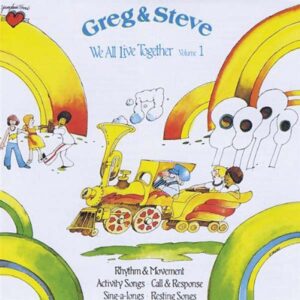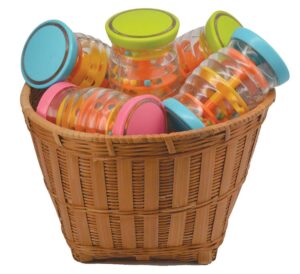Fine motor development
Toddlers move shakers in different positions as part of listening to a song.



[Move a shaker as you invite toddlers to join you. Sit on the floor with toddlers.]
Here are shakers.
[Give each toddler one shaker. Distribute each shaker so the handle is out for a toddler to grasp.
Hold the round part of your shaker with both hands prominently in front of you.]
Look at how I am holding my shaker. Is this the best way to hold a shaker?
[Encourage toddlers to tell and show you how to hold a shaker.]
Let’s practice shaking our shakers!
[Encourage toddlers to shake their shakers for a brief period of exploration.]
I am going to sing a song that will help us move our shakers. It will be fun to move our shakers to music.
We need to listen carefully to the words in the song. We will move our shakers when the words say “shake, shake, shake.” We will stop our shakers when we hear the word “stop.”
Let’s put our shakers in our lap (or in both of our hands) when it is time to stop.
[Demonstrate putting your shaker in your lap or in both of your hands. Explain this is what we do when the song says “stop.”]
Remember, we use our ears to listen carefully.
[Sing the adjacent “Shake Our Shakers” song, moving your shaker with the words and music. Encourage toddlers to move their shakers. Put your shaker in your lap (or in both hands) when it is time to stop.]
Shake Our Shakers
[Sing with a quick tempo to the tune of
“Mary Had a Little Lamb”]
We start our shakers, shake, shake, shake,
Shake, shake, shake,
Shake, shake, shake,
We make our shakers hop, hop, hop
And then it’s time to stop.
[Enthusiastically acknowledge toddlers’ efforts. Emphasize that we moved our shakers when the song said to “shake, shake, shake.” We worked hard to stop shaking our shakers when our song said “it’s time to stop.”]
Part of our song says “hop, hop, hop.” Let’s think about how we make our shaker go “hop, hop, hop.”
One idea is to put our shakers up and down like this. And then move our shaker up and down.
[Hold your shaker straight up. Then move the shaker up and down as you say “hop, hop, hop.”]
Let’s try it together. We can make our shakers go “hop, hop, hop!”
[Lead toddlers in the “hop, hop, hop” action described above. Offer positive comments about their efforts.]
Let’s do our shaker song one more time! I will sing all of the song again. We move our shakers when I start singing. Listen carefully for the “hop, hop, hop” part of our song.
 [Sing the song and lead toddlers in moving their shakers. Point to your ear just before the “hop, hop, hop” part of the song. Emphasize the “hop, hop, hop” position of your shaker. Put your shaker in your lap at the end of the song.]
[Sing the song and lead toddlers in moving their shakers. Point to your ear just before the “hop, hop, hop” part of the song. Emphasize the “hop, hop, hop” position of your shaker. Put your shaker in your lap at the end of the song.]
We are learning how to move our shakers to a song. We listened carefully to the words of our song. We tried to move our shakers in a different way when the song said “hop, hop, hop.” Does our shaker make a sound when we stop moving it?
The activity extends a Block 7 opportunity to move an object as part of listening to a song. The current activity’s use of a shaker differs in several ways from the Block 7 use of a bell. In addition to offering a different sound and feel, the shaker is held in a distinct upright position for “hop, hop, hop.”
Coordinating the shaker with the song may be challenging for some toddlers. Consider offering more practice over time. Some toddlers may participate best if they can move their bodies as part of shaking their shaker. You may wish to adapt the activity to accommodate toddlers’ need for gross motor movement. Encourage toddlers to stop moving their body when the song says “stop.”
Extra support
Enrichment
Fine motor development
Toddlers practice moving and stop moving a shaker as part of listening to a recorded song.



Be Prepared: Place the CD player or digital device close to you so you do not need to stand to start and stop the music in this activity.
 Invite 3–4 toddlers to join you in shaking our shakers. Sit facing toddlers. Give each toddler one shaker. Encourage toddlers to hold the shakers with both hands so it is not moving. Explain: “Our hands are not moving. The shakers are not moving. We do not hear shaker sounds.”
Invite 3–4 toddlers to join you in shaking our shakers. Sit facing toddlers. Give each toddler one shaker. Encourage toddlers to hold the shakers with both hands so it is not moving. Explain: “Our hands are not moving. The shakers are not moving. We do not hear shaker sounds.”
Lead toddlers in several brief practice rounds of start and stop action with their shakers. Then sing the “Shake Our Shakers” song from Option 1 and encourage toddlers to move their shakers to your singing, remembering the position of their shaker for “hop, hop, hop.”
 Show the CD cover and explain that we can start moving our hands to make shaker sounds when we hear the music. Our hands will stop moving when the music stops. It will be quiet.
Show the CD cover and explain that we can start moving our hands to make shaker sounds when we hear the music. Our hands will stop moving when the music stops. It will be quiet.
Play the song “We All Live Together.” Lead toddlers in shaking their shakers. Stop the music after about 30 seconds. Explain: “We moved our hands and made shaker sounds when the music was playing. The music stopped and we stopped moving our hands! We are learning to start and stop moving our hands. Let’s try it again.”
Provide another round of practice, starting and stopping the music several times.
The activity has the challenge of hearing recorded music and following requests to stop when the music stops. Music is highly engaging for most children, and the task of starting and stopping a fine motor action can be more difficult with music than with simple verbal prompts. Some toddlers may respond in their own way to recorded music and forget the plan to stop shaking a shaker when the music stops. Offer a friendly reminder and remember it takes time to develop skill in acting in response to music.
Extra support
Enrichment
Fine motor development
Toddlers move shakers at fast and slow tempos and in different positions as part of listening to a song.



 Invite 3–4 toddlers to join you for some fun in shaking our shakers. Engage toddlers in shaking our shakers slowly and then quickly. Then remind toddlers how we can hold our shakers upright. Offer a demonstration that includes shaking. Remind toddlers we hold our shakers upright when we hear the words “hop, hop, hop” in our song.
Invite 3–4 toddlers to join you for some fun in shaking our shakers. Engage toddlers in shaking our shakers slowly and then quickly. Then remind toddlers how we can hold our shakers upright. Offer a demonstration that includes shaking. Remind toddlers we hold our shakers upright when we hear the words “hop, hop, hop” in our song.
Explain that you will sing our song for shaking shakers. First you will sing the song slowly. We will shake our shakers slowly. Remind toddlers that we hold our shakers straight up when we hear the words “hop, hop, hop” in our song. Then explain you will sing the song faster. We will move our shakers faster. Remind toddlers we need to listen carefully to our song’s words and whether the song is fast or slow.
Sing the Option 1 song at a slow tempo. Encourage toddlers to move their shakers as you sing the song. Invite toddlers to sing with you. Give a signal, such as pointing to your ear, just before the “hop, hop, hop” words. Prominently hold your shaker in an upright position during “hop, hop, hop.” Remind toddlers to stop their shakers when you say stop at the end of the verse.
Repeat the song at a faster tempo, again encouraging toddlers to move their shakers as you sing the song and hold shakers upright at the designated point. Conclude the activity by describing how we used our hands to move our shakers in different ways: fast, slow, upright.
This activity combines the shaker position (upright) task of Option 1 with attention to fast and slow tempos. The tempo remains the same once you begin singing the song, providing motor planning time for the upright position of the shaker during “hop, hop, hop.” Positively accept variations in how toddlers manage the activity, and remember that toddlers cannot be expected to move their shakers in unison or necessarily follow the rhythm.
The slow and fast hand movements in this activity connect with the slow and fast gross motor movements in the current block’s Self-Regulation activity in which toddlers are invited to pretend they are a cornstalk moving in strong and calmer wind. See Extra Support tip.
Extra support
Enrichment
 Materials Needed: basket of shakers
Materials Needed: basket of shakers
Provide a basket of shakers so toddlers may continue exploring how to manipulate shakers. Encourage toddlers to say “start” and “stop” as they begin shaking their shakers and stop shaking their shakers. Point out consequences of toddlers’ actions with the shakers. Example: “Liam, your shaker stopped making noise when it stopped moving!”
In addition to offering Options 1–3 with toddlers, as appropriate, encourage older children to shake their shakers in different patterns, such as the following:
Shake—Shake—Stop
Shake—Stop—Shake—Stop
Begin the activity with longer pauses between each action as children practice starting and stopping. Offer shorter pauses as children become accustomed to the pattern. Toddlers who participate in this variation for older children may wish to continue shaking their shakers rather than following the pattern.